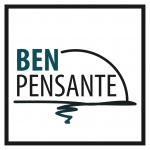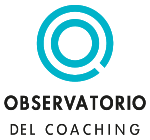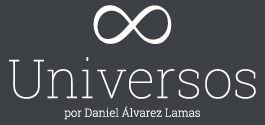Thought Form Constellations as Measures of Team Connectivity
Por Otto Laske, IDM
Abstract
In this article, the author proposes structural, rather than behavioral or social-emotional, measures of team connectivity. These measures are derived from DTF, his Dialectical Thought Framework, a methodology rooted in cognitive-developmental research since 1975. The author teaches DTF to both individuals, especially coaches, and teams, in hands-on workshops in English and German, and with the help of a translator also in Spanish and Italian.
Given that cross-functional teams have become the backbone of work in many organizations, whether hierarchical or ‘agile’, the topic of how well members of a team understand each other and, on account of it, work together, is becoming an important issue. The question arises of what is the meaning of connectivity and collaborative capacity of teams, and how to develop and to measure it. Both of these terms are still largely undefined, whether they are considered in a psychological (behavioral), socialemotional, or cognitive sense of human functioning. Clearly supporting connectivity and collaborative capacity in teams would benefit from greater precision in defining and assessing the three aspects named.
In the Constructive Developmental Framework (CDF; https://en.wikipedia.org/wiki/Constructive_developmental_framework), each of the three aspects has a well-defined meaning. The framework represents a specific perspective on human functioning at work which can be detailed by three pertinent questions in the foreground of team members day-to-day work:
1. Behavioral: “how am I doing (in the team)?”
2. Social-emotional: “what should I do and for whom?”
3. Cognitive: “what can I do and what are my options?”.
Seen in light of these fundamental questions, team connectivity and collaborative capacity (for the moment considered synonyms) have entirely different meanings for individual team members:
1. NP [behavioral]: “Is my self concept, approach to tasks, and interpersonal perspective compatible with those of other team members?”; and “what self-imposed and external pressures hinder me from optimally fulfilling my personal needs at work?” 2. ED [social-emotional development]: “Do I function based on an embodied value system that defines me as self authoring, or am I in an other-dependent position in which I am directed by others’ expectations of me?” 3. CD [cognitive development]: “What I can do and what are my options, as defined by my present way of conceptualizing (understanding) the real world and my place in it, and how could I by way of holistic and systemic thinking transform my work experience, thereby broadening my options?”
As the reader may have noticed, questions regarding the coordination of competences around a particular work focus in the team are seen here as subordinate to experiential questions of team members. Answers to questions of competence logistics simply would not answer the three ‘existential’ questions above. The reason is simple: the outcome of team work is not a function of ‘competences’ per se – except purely logistically. Rather, the outcome of team work is a function of how available competences are USED in real time, and this use entirely depends on answers team members give to the three existential questions outlined above (NP, ED, CD for short)
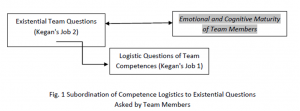
Here, the box at the upper right (in italics) represents Kegan’s «Job 2» (Kegan & Lahey 2016), while the middle box represents his «Job 1». While Job 1 is about getting team work done, Job 2 is about each team member’s psychological and developmental need to protect his/her own personal identity and ‘save face’.
Wherever Job 2 overtakes Job 1 in team members’ experience, the team loses connectivity. This occurs because the challenges (pressures) embodied in team members’ psychological profile are activated, as are the regressive tendencies in their social-emotional profile, and the potential inherent in their cognitive profile is diminished. In short: team members’ optimal ability to use their competences (whatever they are) is reduced.
Given the outline above, it would seem that attempts at enhancing team connectivity have so far only been addressed from a partial, behavioral, perspective, that of: “how are we doing in our work together in terms of our personal process, and how might this influence our task process in which we pursue common goals, whether short- or long-term?” Or, to put it critically, the question that actually determines team work outcomes, the one regarding the social-emotional and cognitive experience of team members at work (Job 2), has not been asked. Consequently, answers given to questions regarding connectivity (focused on Job 1) are not going to be very enlightening or productive.
While the question of “what should I do and for whom” is of great relevance in teams since answers to it indicate a team member’s notion of responsibility for work in a role, an even more relevant question is the cognitive one (question no. 3 above) that asks “what can I do?» — based on how I conceptualize my position in the team, the position of the team in the network of teams, the client I work on behalf of, and my company in the broader market and ecological niche?” The reasons for that is, again, quite simple (and can be understood from reading the adult-developmental literature since 1975 summarized in CDF):
Adult development represents a ‘vertical’, learning a ‘horizontal’, dimension; the former sets limits to the latter, not the other way around.
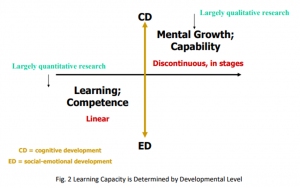
Both a team member’s psychological and social-emotional profile (NP, ED) is largely beyond the influence of learning. They are both imperturbably what they are. The first profile gets only slightly refined over the lifespan, while the second is beyond the reach of learning and training, changing only by experience over relatively long time spans (years), and discontinuously, starting with the breakdown of an anachronistic world view. In contrast, a team member’s cognitive profile (CD) is relatively open to the influence of learning, in a way that is apt to influence adult developmental maturity, even the psychological profile. It is the real driver of adult development.
Accepting this adult-developmental perspective, it comes to be of interest to know how the cognitive profile is defined and what it practically entails for work in teams, especially in an ‘agile’ work situation where each team member is supposed to be able to take on any role required of him or her in a particular situation.
A short explanatory outline will have to do here. It has been shown in the cognitive-developmental literature since 1975 that a highly informative way of assessing individual and team intelligence is provided by investigating team members’ fluidity of thinking, and that this ‘fluidity’ has crucially to do with broad and adventurous perspective taking. Fluidity of thinking in teams has been shown to be based on a broad range of thought forms that can be brought into play in team work, and these thought forms can most usefully be seen as explicating four different perspectives on the real world (not just the social world), as follows:
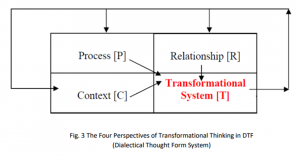
Every one of these four perspectives is a set of mind openers. To explain:
a. In the Context perspective [C], team members’ thinking is focused on a situation’s or event’s big picture including its stratification in terms of layers, relationships of parts to the whole, and the requirement to view any situation or event from multiple perspectives. (This is attempted by systems thinking except that layers and intrinsic relationships get short shrift in that approach, just as in logical thinking.)
b. In the Process perspective [P], what is ‘missing in’ but also ‘possible in’ a situation or event is in focus, with the result that the thought forms brought to bear on them focus on illuminating ‘what is absent’ or ‘not (yet) there’, thus opening team members’ mind to the many unknowns and potentials of a situation or event.
c. In the Relationship perspective [R], team members’ thinking is holistic, directed to the common ground of outwardly different (even opposite) but intrinsically related components of a situation or event, with the result that their attention is focused on critique of reductionism, the value of bringing into relationship, and patterns of interaction that explain the dynamics of a total situation.
d. As indicated by the internal and external arrows in Fig. 3, from the vantage point of Transformation [T], the C, P, and R perspectives are all required for grasping transformation (inner arrows) while CPR are at the same time incomplete ways of understanding a world in unceasing transformation. Only team members able to understand the contextual, process, and relationship aspects of a situation or event (already) are also able to conceptualize events or situations as being in unceasing transformation.
For example, ‘creating value for a client’ is a complex undertaking that, when not seen from the outset as a moving target encompassing many diverse components, is likely to fail. While the contextual aspects of a work process are relatively easy to scan, its process-related and relational implications can only be understood gradually, «sprint by sprint», and how the initially designed value proposition is going to transform over time is initially totally unknown.

How, then, can one practically focus on the cognitive profile of team members, and how can fluidity of thinking in a team be measured?
As indicated by the inner arrows in Fig. 4, we can conceive of the thinking in teams as structured in the form of two kinds of search: breadth-first and depth-first. Both of these kinds of search are «mind opening», in different ways. Breadth-first search opens up the vista from Context to Process and on to Relationship and Transformation (CPRT) and can be seen as «anticipating and unfolding», while depth-first search deepens each of these perspectives by way of individual thought forms (TF 1-12 in Fig. 4) and can be seen as «synthesizing» (gathering) but also “narrowing”.
Clearly, a facilitator, whether of conventional or agile teams, will want to begin working from a small set of thought forms in order to model for the team ‘fluid’ thinking. Once s(he) has learned to use the table above, the facilitator needs to be an exquisite listener since his/her primary task is to discern “how the team is thinking” about an event, or a situation, task focus, situational review, etc., at a specific moment in real time. (I call that “Dialectical Thought Form training”).
For instance, in a particular team situation the facilitator may say: “in my perception, the seeming conflict we are in right now is due to the fact that (team member) A is viewing the situation in terms of TF2 (structure of the present value we are aiming to deliver) while B is thinking in terms of TF4 (where what is presently absent from our proposed solution is in focus). Therefore, we need to try to put both TF2 and TF4 together, if not also add TF7 in order to bring into relationship the intermediate solution we now conceive of with what is still missing from it.”
It should be evident that, while working, team members constantly move from one TF to another, thereby creating in real time “constellations” of various length and depth such as <tf2tf4tf7tf10>. Team members’ movements-in-thought can easily be made visible in a cognitive behavior graph that show their moves in thought over an entire team meeting. It can then be shown that they are moving from one constellation, A, to another, B, and so forth. Such “thought form constellations” are the very essence of team collaboration in real time, especially in team members’ Task Process, but also their Personal Process (in the sense of E. Schein).
One caveat regarding team learning is in order. While teams with a majority of social-emotionally highly developed team members (called downwardly divided teams) are apt to be able to follow the facilitator, teams whose (ED) structure shows a majority of less developed team members (called upwardly divided teams) may have an incomplete grasp of the thought forms used by its minority, including the facilitator. In this case, we are dealing with a cognitively split team whose grasp of the thought form constellations driving the team’s work is deficient, thus hindering the team’s progress.
How, then, can we measure team connectivity?
Evidently, whether the facilitator works with 12 or, as in DTF, 28, thought forms, his/her ability to listen to the team structurally — in terms of TFs (thought forms) rather than mere content — strongly supports the emergence of fluid thinking in the team. This supporting function can be further strengthened in a “train the trainer program” where the facilitator’s TF=based listening can be further distributed and shared in the team, enough to override getting stuck in the logistics of how one competence perspective collides with or modifies another.
As a matter of fact, focusing on the logistics of competence distribution and use are then likely to appear as a deficient approach to creating value for clients: clients are not interested in competences per se (even their own), but only in how such competences are USED in real time, from sprint to sprint. And the use of competences depends on the degree of awareness of “how are we thinking here” and “how could we be thinking about this issue entirely differently, following different thought forms?”
One option for training trainers in transformational thinking would be to use “structural” or “cognitive”, rather than managerially anchored, systems constellations. In such constellations a particular problem becomes visualized and embodied by electing problem representatives and putting them into a public space (constellation) in which they interact with the facilitator for the sake of «(be)coming clear», not only regarding issues of their personal, but also their task, process.
While in team members’ personal process, a psychological and/or social-emotional perspective would be pursued in a constellation, in their task process (oriented to creating value for the client) their TFbased movements in thought would be in focus, and would be both elicited and supported by the facilitator and, increasingly, by cognitively advanced team members.
In this way it would become helpfully apparent that ‘competences’, while important for the logistics of value creation, are incidental to team work, while team members’ fluidity of thinking in terms of transformational TFs is the true foundation of team connectivity and collaborative capacity, even for resolving issues arising in team members’ personal, rather than their task, process.


